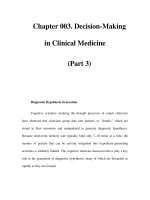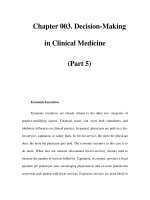Chapter 003. Decision-Making in Clinical Medicine (Part 10) pps
Bạn đang xem bản rút gọn của tài liệu. Xem và tải ngay bản đầy đủ của tài liệu tại đây (16.11 KB, 6 trang )
Chapter 003. Decision-Making
in Clinical Medicine
(Part 10)
Sources of Evidence: Clinical Trials and Registries
The notion of learning from observation of patients is as old as medicine
itself. Over the last 50 years, our understanding of how best to turn raw
observation into useful evidence has evolved considerably. Case reports, personal
anecdotal experience, and small single-center case series are now recognized as
having severe limitations to validity and have no role in formulating modern
standards of practice. The major tools used to develop reliable evidence consist of
the randomized clinical trial and the large observational registry. A registry or
database is typically focused on a disease or syndrome (e.g., cancer, CAD, heart
failure), a clinical procedure (e.g., bone marrow transplantation, coronary
revascularization), or an administrative process (e.g., claims data used for billing
and reimbursement).
By definition, in observational data the care of the patient is not controlled
by the investigator. Carefully collected prospective observational data can achieve
a level of quality approaching that of major clinical trial data. At the other end of
the spectrum, data collected retrospectively (e.g., chart review) are limited in form
and content to what previous observers thought was important to record, which
may not serve the research question under study particularly well. Data not
specifically collected for research (e.g., claims data) will often have important
limitations that cannot be overcome in the analysis phase of the research.
Advantages to observational data include the ability to capture a broader
population than is typically represented in clinical trials. In addition, observational
data are the primary source of evidence for questions where a randomized trial
cannot or will not be performed. For example, it may be difficult to randomize
patients to test diagnostic or therapeutic strategies that are unproven but widely
accepted in practice. In addition, we cannot randomize patients to a gender,
racial/ethnic group, socioeconomic status, or country of residence. We are also not
willing to randomize patients to a potentially harmful intervention, such as
smoking or overeating to develop obesity.
The major difference between a well-done clinical trial and a well-done
prospective observational study of a particular management strategy is the lack of
protection from treatment selection bias in the latter. The underlying concept in
the use of observational data to compare diagnostic or therapeutic strategies is that
there is enough uncertainty in practice that similar patients will be managed
differently by different physicians. In short, the assumption is that there is an
element of randomness (in the sense of disorder rather than in the formal statistical
sense) to clinical management. In such cases, statistical models can be used to
adjust for important imbalances and "level the playing field" so that a fair
comparison among treatment options can be made. When management is clearly
not random (e.g., all eligible left main coronary artery disease patients are referred
for coronary bypass surgery), the problem may be too confounded for statistical
correction, and observational data may not provide reliable evidence.
In general, use of concurrent controls is vastly preferable to historical
controls. For example, comparison of current surgical management of left main
coronary artery disease with left main patients treated medically during the 1970s
(the last time these patients were routinely treated with medicine alone) would be
extremely misleading since the quality of "medical therapy" has made huge
improvements in the interval.
Randomized controlled clinical trials include the careful prospective design
features of the best observational data studies but also include the use of random
allocation of treatment. This design provides the best protection against
confounding due to treatment selection bias (a major aspect of internal validity).
However, the randomized trial may not have good external validity if the process
of recruitment into the trial resulted in the exclusion of many potentially eligible
subjects.
Consumers of medical evidence need to be aware that randomized trials
vary widely in their quality and applicability to practice. The process of designing
such a trial often involves a great many compromises. For example, trials designed
to gain FDA approval for an investigational drug or device will need to address
certain regulatory requirements that may result in a different trial design from
what practicing clinicians would find useful.
Meta-Analysis
The Greek prefix meta signifies something at a later or higher stage of
development. Meta-analysis is research done on research data for the purpose of
combining and summarizing the available evidence quantitatively. Although it can
be used to combine nonrandomized studies, meta-analysis is most valuable when
used to summarize all of the randomized trials on a particular therapeutic problem.
Ideally, unpublished trials should be identified and included to avoid publication
bias (i.e., "positive" trials are more likely to be published). Furthermore, some of
the best meta-analyses obtain and analyze the raw patient-level data from the
individual trials rather than working only with what is available in the published
reports of each trial. Not all published meta-analyses are reliable sources of
evidence on a particular problem. Their methodology must be carefully scrutinized
to ensure proper study design and analysis. The results of a well-done meta-
analysis are likely to be most persuasive if it includes at least several large-scale,
properly performed randomized trials. In cases where the available trials are small
or poorly done, meta-analysis should not be viewed as a remedy for the deficiency
in primary trial data.
Meta-analyses typically focus on summary measures of relative treatment
benefit, such as odds ratios or relative risks. Clinicians should also examine what
absolute risk reduction (ARR) can be expected from the therapy. A useful
summary metric of absolute treatment benefit is the number needed to treat (NNT)
to prevent one adverse outcome event (e.g., death, stroke). NNT is simply 1/ARR.
For example, if a hypothetical therapy reduced mortality over a 5-year follow-up
by 33% (the relative treatment benefit) from 12% (control arm) to 8% (treatment
arm), the absolute risk reduction would be 12% – 8% = 4% and the NNT = 1/4 or
25. Thus, we would need to treat 25 patients for 5 years to prevent 1 death. If we
applied our hypothetical treatment to a lower-risk population, say with a 6% 5-
year mortality, the 33% relative treatment benefit would reduce absolute mortality
by 2% (from 6 to 4%) and the NNT for the same therapy in this different group of
patients would be 50. Although not always made explicit, comparisons of NNT
estimates from different studies need to take account of the duration of follow-up
used to create each estimate.









